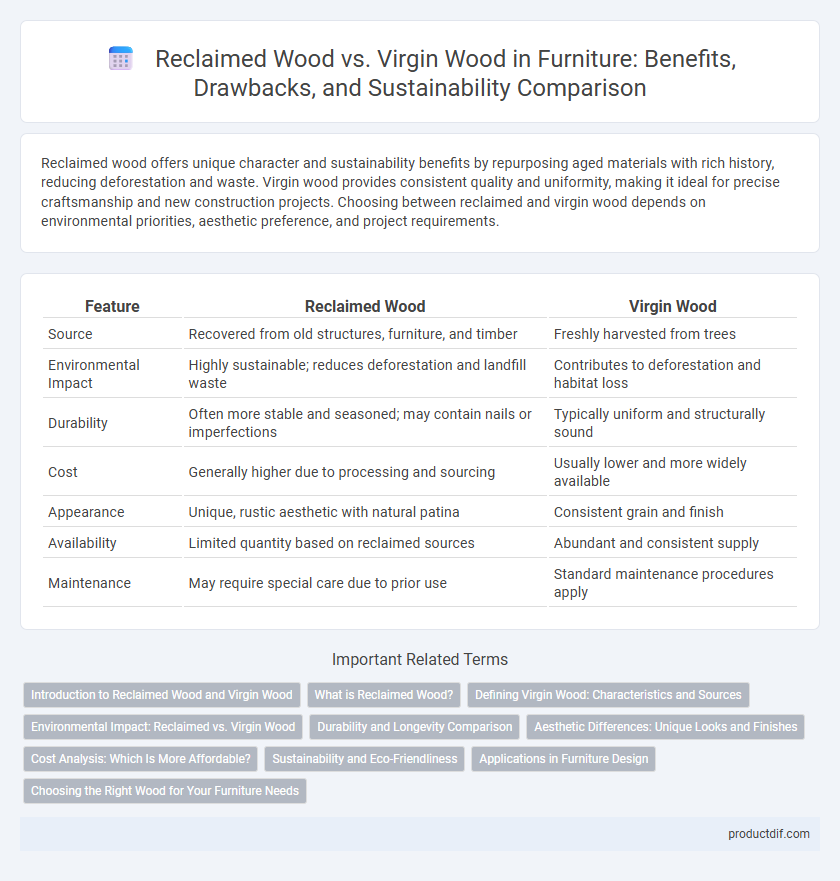Reclaimed wood offers unique character and sustainability benefits by repurposing aged materials with rich history, reducing deforestation and waste. Virgin wood provides consistent quality and uniformity, making it ideal for precise craftsmanship and new construction projects. Choosing between reclaimed and virgin wood depends on environmental priorities, aesthetic preference, and project requirements.
Table of Comparison
| Feature | Reclaimed Wood | Virgin Wood |
|---|---|---|
| Source | Recovered from old structures, furniture, and timber | Freshly harvested from trees |
| Environmental Impact | Highly sustainable; reduces deforestation and landfill waste | Contributes to deforestation and habitat loss |
| Durability | Often more stable and seasoned; may contain nails or imperfections | Typically uniform and structurally sound |
| Cost | Generally higher due to processing and sourcing | Usually lower and more widely available |
| Appearance | Unique, rustic aesthetic with natural patina | Consistent grain and finish |
| Availability | Limited quantity based on reclaimed sources | Abundant and consistent supply |
| Maintenance | May require special care due to prior use | Standard maintenance procedures apply |
Introduction to Reclaimed Wood and Virgin Wood
Reclaimed wood originates from repurposed sources such as old barns, factories, and warehouses, offering unique character, durability, and environmental benefits by reducing the demand for freshly harvested timber. Virgin wood, on the other hand, is sourced directly from newly cut trees, ensuring uniformity, predictable grain patterns, and a wide range of species for furniture manufacturing. Selecting between reclaimed and virgin wood impacts sustainability, aesthetic appeal, and the overall cost of furniture projects.
What is Reclaimed Wood?
Reclaimed wood is timber that has been salvaged from old structures such as barns, factories, and warehouses, offering a sustainable alternative to virgin wood. This wood often features unique textures and weathered patinas due to years of exposure, enhancing the character and aesthetic appeal of furniture. Using reclaimed wood reduces deforestation and minimizes environmental impact by repurposing existing materials.
Defining Virgin Wood: Characteristics and Sources
Virgin wood, sourced directly from newly harvested trees, is characterized by its untouched grain, uniform texture, and consistent density, ensuring superior structural integrity in furniture construction. This type of wood typically comes from sustainably managed forests, where logging is regulated to prevent deforestation and maintain ecological balance. Furniture crafted from virgin wood offers longevity and a clean aesthetic, making it a preferred choice for high-quality and durable wooden products.
Environmental Impact: Reclaimed vs. Virgin Wood
Reclaimed wood significantly reduces environmental impact by minimizing deforestation and lowering carbon emissions through the reuse of existing materials. Virgin wood requires extensive harvesting, leading to habitat destruction and increased carbon footprint due to logging and processing. Choosing reclaimed wood promotes sustainability and conserves natural resources while maintaining durability in furniture production.
Durability and Longevity Comparison
Reclaimed wood typically offers exceptional durability due to its aged and weathered nature, often surpassing virgin wood in resistance to warping and cracking. Virgin wood, while fresh and uniform, may lack the density and stability found in reclaimed timber, which has already undergone natural drying and curing processes. Choosing reclaimed wood enhances furniture longevity, as its established strength and seasoning reduce the risk of deterioration over time compared to new-growth lumber.
Aesthetic Differences: Unique Looks and Finishes
Reclaimed wood features distinctive grain patterns, weathered textures, and a rich patina that create a one-of-a-kind aesthetic unmatched by virgin wood. Virgin wood offers a cleaner, more uniform appearance with consistent color and smoother finishes, ideal for modern or minimalist designs. The natural imperfections and aged character in reclaimed wood provide warmth and history, making each piece a unique statement in furniture design.
Cost Analysis: Which Is More Affordable?
Reclaimed wood often presents a higher upfront cost due to the labor-intensive process of sourcing and preparing aged materials, whereas virgin wood typically costs less because of its widespread availability and standardized production methods. However, choosing reclaimed wood can offer long-term savings by reducing waste and potentially increasing the value of custom or eco-friendly furniture pieces. Evaluating factors like durability, sourcing expenses, and environmental impact helps determine which wood option is truly more affordable for specific furniture projects.
Sustainability and Eco-Friendliness
Reclaimed wood significantly reduces environmental impact by minimizing deforestation and lowering carbon emissions associated with processing virgin wood. Its reuse preserves natural resources and diverts waste from landfills, promoting a circular economy in furniture production. Virgin wood, while renewable when sourced responsibly, often involves harvesting practices that contribute to habitat loss and higher energy consumption, making reclaimed wood the more sustainable and eco-friendly choice.
Applications in Furniture Design
Reclaimed wood offers unique character and sustainability benefits ideal for rustic, vintage, and eco-friendly furniture designs, while virgin wood provides consistent quality and availability suited for modern, sleek, and high-end furniture manufacturing. The distinct textures and weathered finishes of reclaimed wood add aesthetic value to bespoke tables, cabinets, and shelving units. Virgin wood's uniform grain and strength make it preferable for precision-crafted chairs, bed frames, and cabinetry requiring structural integrity and smooth finishes.
Choosing the Right Wood for Your Furniture Needs
Reclaimed wood offers unique character and sustainability benefits by repurposing aged lumber, making it ideal for eco-conscious furniture buyers. Virgin wood provides consistent quality and a wide range of options, perfect for custom designs requiring uniformity and strength. Selecting the right wood depends on factors like environmental impact, durability, and aesthetic preferences to match your specific furniture project.
Reclaimed wood vs virgin wood Infographic

 productdif.com
productdif.com